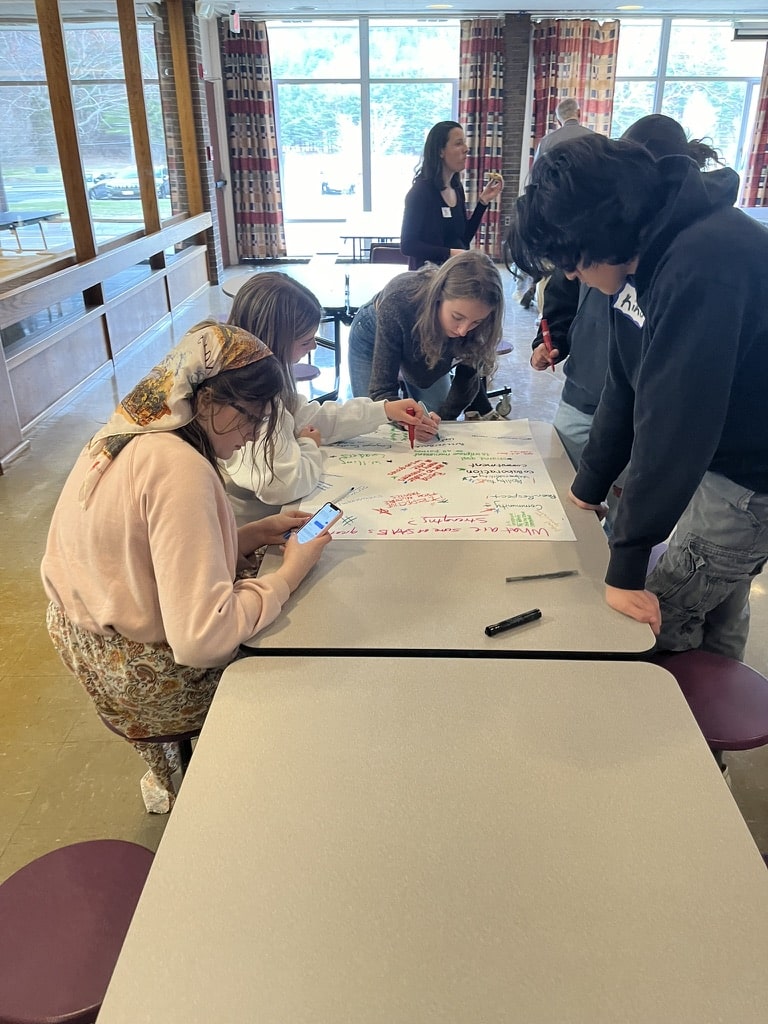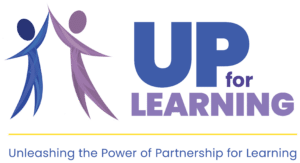UP’s Program Directors Harry Frank and Katie Ingraham have been working with youth and adults at Monument Mountain Regional High School in Great Barrington, MA for three years. This week, UP’s Communication Director Christie Beveridge sat down with Katie to hear about highlights from their most recent retreat. The following are excerpts from their conversation.
What were the goals of the retreat?
UP for Learning and the Student Adult Advisory Board (SAAB) Steering Committee gathered for a working dinner on March 19th to design a retreat for group members to develop their facilitation skills. This retreat honored the committee’s desire to share more leadership and power across the full SAAB. About 30 members attended the training the next day, participating in skill-building activities and grounding into youth-adult partnership. Following each activity, the group brainstormed where they might use it within their community. They talked through what facilitation could look like in each of those spaces, and how they could use the activities to collect data. The youth left the day feeling confident and ready to step into facilitation within their SAAB committees and other places within the school. They also had a lot of fun and laughs throughout the day!
On the third day of our visit, we facilitated a retreat with another team from Monument Mountain, the school’s Restorative Justice (RJ) group. The team started by reflecting on the amazing restorative justice work the school has already been doing in order to know what to bring to a new cohort of peer mediators. Before this retreat, 20 students have been trained as peer mediators, seeing cases involving physical altercations, student to teacher conflict, and peer to peer conflict. They have also led circles in the school’s advisory program. Some members from the RJ team have also been visiting classes at the middle school, leading small group discussions around vaping and other substance use. The group used this previous work to design a dynamic training for the new peer mediators. The day’s activities included reflecting on the Three Tiers of Restorative Justice, time for current mediators to share their experiences, learnings and challenges, and role-playing different scenarios.

Highlights of the SAAB Facilitation Retreat:
The beauty of Monument Monument is that the team of youth and adult facilitators is quite large. Each activity was co-facilitated by a youth and adult member, which distributed leadership and facilitation in a dynamic way. The Strengths/Opportunities/Vulnerability Circle they facilitated was another highlight of the day. This activity allows for participants to connect and share. One at a time, a group member walks into the center of the circle to share something they believe to be a strength they possess, and after a moment of think time, people join in the center of the circle if they also possess that strength. They then did a round with opportunities for growth. This activity is particularly nice to do with a group focused on facilitation, because effective facilitators bring vulnerability to their work. Another highlight was seeing some of the youth that UP has worked with for a number of years and how far they have grown as facilitators. One facilitator in particular noted that through working with the SAAB and UP, she has been able to build confidence so that she doesn’t just follow a script, but now can add her own thoughts. Throughout the retreat, it was a joy to witness her demonstrate this progress with the whole group, and put it into practice as she led them in activities.
Highlights of the Restorative Justice Retreat:
It was incredible to see the youth facilitators who had co-designed the day take an authentic leadership role during the retreat. Their adult partner ended up not being able to attend at the last minute, and this meant that these youth were the primary knowledge holders. They were able to step into their expertise and experience and lead the new cohort of peer mediators. They talked extensively about how restorative justice functions effectively at their school, and how youth fulfill many different roles within harm repair mediation. There are advocates who meet one-on-one with people involved in the conflict; these advocates then attend the mediation as simply that, an advocate for their person. In each mediation there is also a mediator who leads the conversation. The new peer mediators trained during this session will shadow the current mediators to learn from them over the course of the next few months. A final highlight from this retreat was that one of the facilitators from SAAB also participated in the RJ retreat, and realized that their Wellness Committee is also leading some initiatives around vaping at the middle school. The two teams will now collaborate more, which speaks to the power of groups connecting and being able to support each other’s common efforts.

What have been some challenges?
The SAAB is struggling with how to make the structure of the group as accessible as possible, and are beginning to discuss how to embed it into the school so that it doesn’t feel separate from the community. They also hope to lean more closely into the YPAR (Youth Participatory Action Research) process to ensure that they are creating dynamic opportunities for data collection that are oriented to capturing voices from the entire school and specific groups that they want to engage.
What are the teams’ next steps?
So many thoughts and perspectives were shared over the course of the three days! The members have incredible ideas, and they are working to plan how to effectively merge the SAAB and RJ work in a way that ensures that both processes are accessible to all. The SAAB’s next steps are to consider the structure for next year. They are also working to envision a way to improve communication practices within the wider school community. The RJ group is hoping to replicate their retreat facilitation with middle schoolers. Both have goals to make their groups more representative of the school community as a whole.

